From Liquid Death to Düng, today’s challenger brands are defying conventional naming conventions. And while not without risk, the rewards can be great
Anyone fancy a nice, big mouthful of Düng? It’s not the most obvious name for a snack bar range, but one thing it’s certainly not is boring. But it’s not even that unusual these days.
Düng is among a new wave of challengers – others include Who Gives a Crap toilet paper and I Am Nut OK vegan cheese – that are ditching traditional naming conventions, based on ingredients, or texture or even something cutesy or aspirational, in favour of arresting, in-your-face and challenging names to shock shoppers into purchasing them.
“Names are important. They can really supercharge your brand,” says Jonathan AJ Wilson, a professor of brand strategy and culture at Regent’s University London. But while noting the proliferation of the unconventional approach, he points out such names also risk alienating customers or ageing poorly.
So how do brands arrive at these types of names? And what does it take to make them work?
Water brand Liquid Death is a prime example of a category disruptor with an unmissable name. Founded in 2017, it made its UK debut last April and fuelled by its irreverent name and ‘heavy metal’ ethos was valued at $1.4bn (£1.14bn) earlier this year.
“In the very early days, some people didn’t think retailers would actually sell a product with ‘death’ in the name,” says founder and CEO Mike Cessario. “But in 2023, we hit 113,000 retail doors in the US and UK.”
Name-wise, there was no lightbulb moment, though. Cessario spent two years honing the concept while coming up with the right name. Along the way, he discarded several others, including Southern Thunder, which he feels might have engendered more of a “craft beer persona”.
Liquid Death
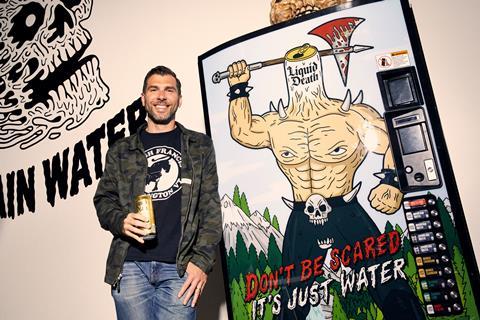
What: Water
Who: Mike Cessario
When: 2017
Why: “The reason people buy Nike over Adidas has nothing to do with the specific materials Nike uses or how many days longer their shoes last, or what equipment they use in the manufacturing process,” says Cessario. “The reasons people make decisions to buy products are rarely ever rational, but instead emotional.”
The process was similarly lengthy for challenger brand Düng snack bars, launched in 2023. “We spent so long generating and collating brand name options, seeing if the name was already in use in the UK and around the world. Checking for social handles. Checking for domain names. Checking for bad press. It was exhausting,” says co-founder Danny Bull.
“We must have gone through 40 or 50 name ideas, finally settling on one we loved: Forage Snacks. We took that one right through branding, package design, domain name, website design and socials, only to be scuppered when we tried to register the trademark. We were so dejected.”
When his partner suggested the name Düng, Bull was unconvinced. “I hated it,” says Bull. “But then, after a few days the name wouldn’t leave my brain.” In the end, his experience working for Virgin made him reconsider. “I started to think, if Virgin didn’t exist and someone told you they wanted to start a multibillion-pound company with sub-brands in almost every industry on the planet, and call it Virgin, you’d say, ‘no way’.”
Read more:
-
Why we need more food & drink targeted at gen alpha
-
Here’s how fmcg brands can take TikTok to the next level
-
10 women bringing food marketing and influencer culture together
Regent’s Wilson agrees: “Virgin means no experience” – not exactly the optics one wants for an airline. Equally, “if your war chest is big enough, eventually you can make even the most boring names stick”.
Just look at the supermarket shelves to see this principle in action. “That can work for a lot of product categories,” says Wilson. “Toilet paper, for example, is classified as a low-involvement product – you don’t think too much, you don’t [ask] your mates, you don’t test drive it – so if you’ve got a fairly bland name, it doesn’t necessarily condemn you.”
Irrational decision making
But in the cacophony of social media, between an increasingly packed field of challengers and limited retailer shelf space, an eye-grabbing name can certainly help. The trick, says Wilson, is getting people “to make an emotional decision where they’d usually make a rational one”. In other words, the first step to gaining a loyal customer is convincing them to make an impulsive purchase.
Who Gives a Crap toilet paper does just this, leveraging not only its eye-catching name but its colourful packaging to break the mould. Established in 2012 in Australia, the toilet paper brand relied on DTC at first but gained its first UK retail listing in May 2023.
“Because the category is so boring, and… without doing disservice to big brands, pretty dominated by puppy images, it felt like there was an opportunity for disruption”
Emily Kraftman, Who Gives A Crap MD
The name certainly ruffled feathers. “Some people really loved it. Some really hated it,” she says. “If anything, that slight polarisation helped us know we were on to something.” Still, there were also professional naysayers, “marketing experts who told us we should definitely change it”, she adds. “But the benefit of being a young brand is that we sold the product under three different names.” Of the three – Give a Crap, Roll Model and Who Gives a Crap – the latter proved most popular.
Crispy Fantasy

What: Breakfast cereal
Who: Andrea Rodrik, Raphaël Nahoum
When: 2021
How: “They say don’t judge a book by its cover, but you buy with your eyes,” says Rodrik. “And getting on the shelf is not the hard part – it’s flying off the shelf. So brands will do whatever they can. They communicate directly with gen Z via social media, but not every product is meant to be sold online.”
Toxic marketing
Candy brand Toxic Waste also faced pushback early on. “After launch, we found it difficult to convince buyers to take a chance with our unique branding,” says Haley Peyron, marketing manager at parent company Candy Dynamics. “The biggest pitfall for us was in the Middle East. We had to change our brand name to Shock Wave, as the governments ruled we could not be known by Toxic Waste in the region.” That ruling has since been overturned, she says. And buyers no longer need convincing. “Today, we have major retailers actively seeking out our products.”
Vegan cheese brand I Am Nut OK, launched in 2017, got a similar response. “When we approached investors, they were like: ‘Maybe you want to change the name?’” says co-founder Angela Chou. She and her partner pushed back. “When a lot of brands get investment, they try to be safe and water things down, but who’s to say the name hasn’t gotten us where we are?”
She believes it’s important the name fits the brand. “It’s not very serious,” she says, laughing. “We’re making fake cheese. How serious can it be?” But Chou was after broader market appeal in another way – she didn’t want to signpost the brand’s vegan nature. “We didn’t want people to write off our products because of the word ‘vegan’ – a lot of our customers are more flexitarian or just see our products as something different or new to try.”
Badwater Tequila
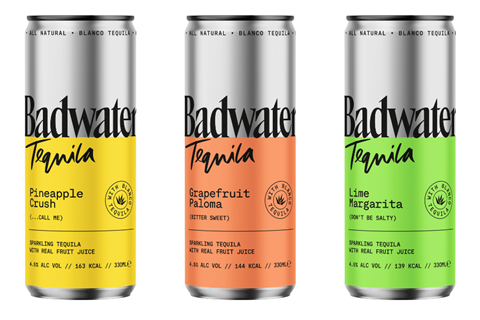
What: Tequila
Who: Dan Spurr, Wes Nelson
When: 2022
Why: “When I first heard the name, it intrigued me,” says Jason Sennitt, COO. “That’s the hallmark of a good brand name – not overly descriptive. There’s no obvious literal translation as to what the name means. Having something which doesn’t tell you immediately what it is… it’s slightly more discursive.”
Choosing a name with a bit of mystique isn’t necessarily a bad thing, agrees Jason Sennitt, COO at Badwater Tequila, launched in 2023. The brand has gone out of its way to avoid the Mexican associations most tequilas deliberately seek out. He says, while provenance is one way to appeal to consumers, “what we’ve seen in recent years is a move away from that. Brand names can be much more creative… Gen Z and younger millennials kind of refuse to be pigeonholed – they rave one night and the next they have classical music queueing on their Spotify.”
Like its target drinker, Badwater sees itself as different from the crowd. “It’s that juxtaposition between the bad boy tequila spirit but being delivered through a lighter, lower-abv, cleaner product,” he says. “The marketing plays on that. The packaging is stripped back, fairly refined, bold in logo. It’s progressive.” The brand’s name was also adaptable enough to see it through a 2024 pivot from hard seltzer to a tequila-based RTD cocktail.
This flexibility was something Jac Chetland, co-founder of Surreal cereal, sought when the brand launched in 2022. “We didn’t want to be tied down to a nutritional credential or shape or format,” he says, citing examples such as Corn Flakes and Weetabix. “We wanted to be a challenger within cereal but also have a name that gives us opportunities to go into other categories… We never built the brand name with one channel in mind.”
Who Gives a Crap

What: Toilet paper
Who: Simon Griffiths
When: 2012
How: “Launching into retail is interesting, because there’s a different type of audience and [you’re working with] retailers as well,” says MD Emily Kraftman. “And you truly are disrupting the aisle when you move to bricks & mortar. The main thing we had to do differently is figure out what our brand looks like in store in smaller packs.”
Substance required
No matter how wacky it is, a brand’s name must match its personality and approach – otherwise it risks ringing hollow. “I think of branding a bit like when you come up with a band name,” says Regent’s Wilson. “It’s meaningless unless it’s backed up with songs, touring and PR… There has to be a meaning, and that has to be constantly renewed and reminded.”
Who Gives a Crap does this by giving customers “little moments of delight” throughout their experience, says Kraftman – for instance, in the rolls’ patterned wrappers and the “emergency roll” that comes at the bottom of the box. “These things are definitely integral to who we are.”
But behind its playful exterior is a more serious mission. The brand aims to reduce deforestation and has penned a no deforestation commitment, alongside frequently reminding shoppers that a million trees a day go into toilet paper. As a social enterprise it also donates half its profits toward clean water and sanitation services in low-income countries, with more than £6m donated to charity partners to date, it says. All of which shows, of course, that the brand most definitely does ‘give a crap’.
I Am Nut OK
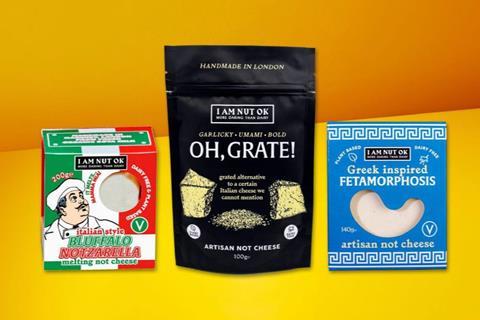
What: Vegan cheese
Who: Angela Chou, Nivi Jasa
When: 2017
Why: “We don’t have a huge marketing budget, so in this case it’s very helpful for the brand to be able to speak for itself,” says Chou. “Word of mouth is a lot easier. People like to talk about interesting brands. If the brand does half the work of being memorable, the customer naturally talks about it.”
There’s a less flippant side to Liquid Death, too. The brand donates a portion of its profits to fighting plastic pollution. “Our evil mission is to make people laugh and get more of them to drink more healthy beverages more often, all while helping to kill plastic pollution,” according to its website.
And of course, the marketing must work with the name. Both brands operate by “almost ridiculing the marketing industry, but also being brilliant at marketing – it’s their way of standing out and attracting different audiences to the category”, says Colin Horan, strategic partner for fmcg at Clear Channel UK.
Wilson even compares Who Gives a Crap to the Sex Pistols. It’s a triumph of clever marketing, he says. “People might think: ‘who would give a brand such a name?’ But quite quickly they follow up with some smart marketing: everything from bright packaging to messages on boxes, to the fact they want you to commit to a larger number of rolls than you’d normally buy.”
Smaller brands can employ the same strategy. Crispy Fantasy cereal – which gets its name from the childhood dreams of its founders who wanted to indulge in cereal without guilt – plays on its name and delights in its opacity. “The fantasy is one that never existed for us as kids,” says co-founder Andrea Rodrik. “Perhaps people mistake us for erotic movies, but that’s also cool.” The marketing makes the most of any such mix-ups with an ad that calls the product “cereal with benefits”.
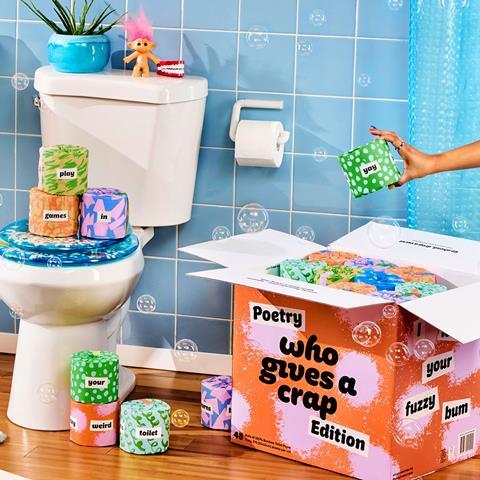
Covering the basics
But even a company that ticks all the boxes – a fantastic product, mission and packaging – still needs to meet a few basic criteria when it comes to brand name. For one, the name must be patentable. It also needs to have basic internet searchability.
“Simplicity, something that’s easy to say and also write [is helpful],” says Clear Channel’s Horan. “I often think about that with band names: if I can’t remember how to say it or spell it, I can’t search for it.”
To head off potential issues down the line, the brand name should ideally also work across languages, says Wilson. He lists Prix chocolate bars as an unfortunate example. “You don’t want a name that’s a laughing stock,” he says.
Meeting such requirements is a useful starting point, but it’s no guarantee. So while Wilson believes names do have the power to “supercharge” a brand, ultimately, long-term success is down to “good, old-fashioned business strategy”, he says. “You can have the best product in the world, with an amazing name, but without the right business strategy, it’s never going to work.”
What’s behind the trend for dropping vowels?
In 2021, luxury fashion brand Vetements launched the label VTMNTS. The idea isn’t new, though. Ten years before, New York-based fashion house BLK DNM started its journey to becoming an international fashion brand. Earlier still, in the mid-2000s, tech sites such as Flickr and Tumblr were dabbling in abbreviation.
More recently, food brands are embracing the vibe. Take sweet maker CNDY. Or SDMN Sides – the nibbles range by the Sidemen (pictured above), which goes into Iceland this June.
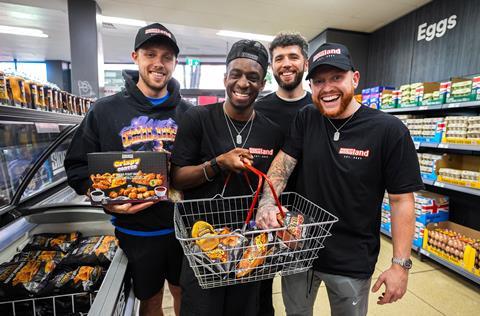
What’s behind the trend? Colin Horan, strategic partner for fmcg at Clear Channel UK, says it may be inspired by early text speak. “In the ’90s and noughties people used to use a ‘z’ for ‘s’ because it was cool. You would never do that now.”
Jonathan AJ Wilson, professor of brand strategy at Regent’s University London, believes the reason may also be pragmatic. “You can spend a lot of time coming up with a name. But it’s much more difficult to come up with a one-word domain name.”
While the all-consonant workaround may be handy, he says it’s also risky: “There’s a real risk the trend could wear out quite quickly, and then the brand becomes uncool.”
Horan agrees. Trends, like food, come with an expiration date. “It feels dated in 10 years.”




















No comments yet